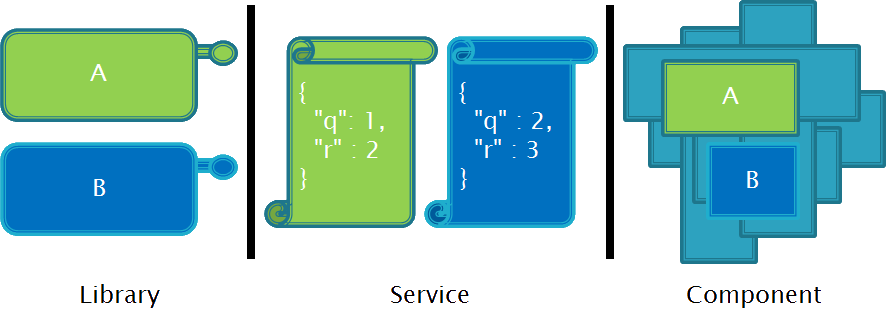Extending an existing system results in tradeoffs depending on where you choose to make the change.
Consider making your changes in one of the following areas:
- A new library along a known boundary
- A new service behind a consistent protocol
- A new component within an existing service
New Requirements
A few weeks ago we had an interesting team discussion about how best to change the system we use to orchestrate updates and deployments for some of our products. The main activities are performed by a series of scripts that call other services or libraries to do additional work. Each piece that makes up the system specializes in a single responsibility. We have also tried to limit the number of operations the overall system performs to focus the design on our current needs.
The services are primarily used to interact with our infrastructure and/or perform long running tasks. One service we have made, Machinator, is used to simplify the creation and deletion of virtual machines. It has a very generic API to abstract the underlying implementation and allow other implementers to use the same contract in the future.
Configuration in Machinator modifies what underlying hardware is used to create new virtual machines. This aligns closely with the underlying hypervisor which simplifies the code and operating the service. This has led to many internal settings that need to be configured which hasn’t always been a bed of roses but we will come back to that in a different post.
We were approached by another team who wanted to use a different virtualization platform and load balancer. The orchestration scripts already did these operations but only in very specific ways and only with integrations we had implemented, like the virtualization consumed by Machinator. This placed new stress on our design because these additions did not belong in the original components. Our challenge was to determine where in the system to make these changes without over complicating future maintenance.
Library, Service or Component?
In talking to my boss, Craig, about the problem, we came up with three areas where we could introduce the new functionality. By replacing one of these building blocks with a different implementation that provided the desired functionality or integration. Using compilation or runtime configuration the system could then determine which concrete implementation to use, such as green or blue in the diagram below. The areas within our scripts/workflow we identified were:
- A library, script, executable or dll along a known boundary
- A service behind a consistent protocol
- A component or classes within an existing service

These options present a range of benefits and trade-offs such as how isolated the change is and the ongoing maintenance cost. The boundary used to isolate the change becomes more important and harder to evolve in the future. For example, replacing Machinator with a service that used the same protocol/contract would make it harder to change the protocol/contract being used. Similarly, adding the functionality using configuration within Machinator would make Machinator more important and harder to maintain in the future.
Using a different library has the lowest operating cost but might impact other things running in the same process. It would make sense to use the same language/runtime and might be necessary depending on how the library is loaded and invoked. This route seems simple and in our system would keep the changes closer to the entry point instead of buried deep within other layers. Another complexity would be if the operation needed to preserve long running state which would make a standalone library less suitable.
Replacing a service can be a natural extension point due to the existing API boundary. Running a new service will undoubtedly need additional hardware and support from operations. There may be more trouble getting started if your teams does not typically write many services and have not optimized for a service oriented or microservice architecture. Since using microservices is the new hotness you can find out the good and bad thanks to all that has been written about it in the past few months.
Depending on the current services their implementations may be easily extended to add the new functionality. Doing so would effectively hide the changes behind the existing service APIs limiting their impact on the rest of the system. There is a risk that this would over complicate the service being updated and dilute its responsibilities. When evaluating this option for Machinator we determined that new configuration would have been needed to choose between the existing functionality and the new capabilities. This approach could make it easier to use a mixture of the old and new functionality at the same time, i.e. creating some virtual machines with each virtualization platform within the same deployment.
Conclusion
In the end we decided to better define boundaries within the scripts so that we could use different libraries. This required more refactoring due to our dependencies against the existing services and processes. The resulting changes helped clarify how the system works and decouple the operations better from the scripts. The service calls were also converted to these new extension points which let us move their implementations closer to the services they consume.
Had we decided to introduce a new service or component this would have increased the effort required to operate the system and configuration complexity. Operators were already not thrilled with the necessary configuration for the system which made these options even less attractive. The teams wanting to make the changes felt comfortable enough with this approach that they contributed the new libraries that were needed.
Next time you are faced with a design decision like this consider whether replacing a library, service or component would work for you.
I would like to thank Michael Swart and Matt Campbell for helping review this and several other early posts.